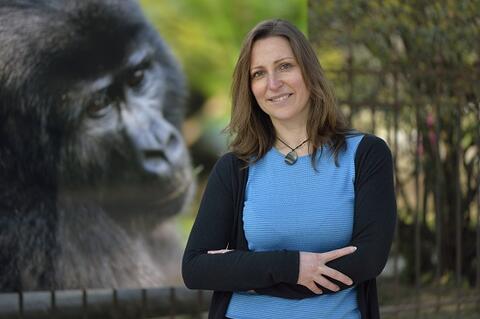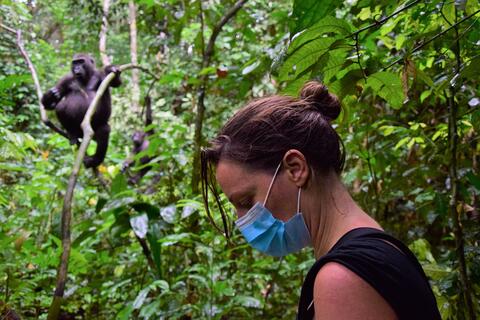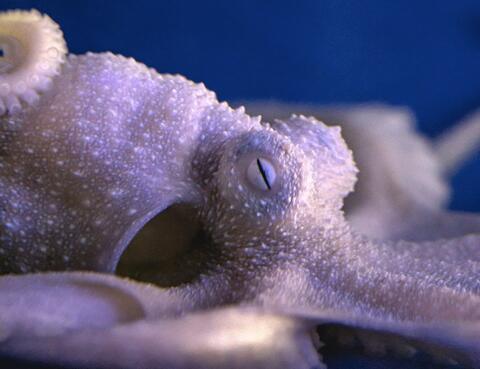
“We share common cognitive abilities with other primates”
For the occasion of World Animal Intelligence Day, February 4, Shelly Masi, primatologist and associate professor at the National Museum of Natural History (Sorbonne University Alliance) and at the Museum of Man, shares with us her thoughts on the intelligence of primates and particularly gorillas, based on her years of observations and research in the natural environment.
How did you become a primatologist?
Shelly Masi: When I was very young, I was passionate about animals and large mammals, although I had a certain apprehension of primates because of television programs which showed them being aggressive towards each other. Everything changed when I was eight years old, when I watched a documentary about mountain gorillas. Among them, two particularly captivated me. They interacted with and petted a chameleon. It was at this very moment that my love for gorillas began. I wanted to understand their sensitivity, their spirit and the empathy they show towards other species. Over the years, I decided to dedicate my life to deepening our understanding of primates, and especially gorillas, and their behaviors and cognitive abilities.
Can you say more about these functions? Can we say that primates are intelligent?
S.M.: Above all, it is important to remember that primates are not our ancestors, but our cousins, with whom we share common cognitive abilities. That said, measuring primate intelligence is a complex challenge. Already, for us humans, we identify at least nine types of intelligence, such as logical or mathematical, social, emotional, natural intelligence, such as understanding the environment. Moreover, chimpanzees and gorillas surpass man in this last aspect.
As a scientist, it is difficult for me to determine whether the chimpanzee or the gorilla is more intelligent, for example. Although the chimpanzee is phylogenetically closer to humans, sharing 98.8% of their DNA and also having similar cognitive abilities, this does not necessarily make them more “intelligent” than the gorilla. Their intelligence manifests itself in distinct ways. For example, chimpanzees are known for knowing how to use tools such as cracking nuts or collecting honey, while gorillas use none or very little in the natural environment. However, if a gorilla in captivity has access to tools, it will demonstrate skillful use of them quite comparable to that of chimpanzees. In the natural environment, the gorilla, the largest primate in the world, often favors brute force over fine manipulation, such as breaking a termite mound to feed on termites, one of their favorite foods.

Shelly Masi sur le terrain © Marcella Sanna
How is the intelligence of primates assessed?
S.M.: Several approaches are used, in particular tasks given to non-human primates in captivity as well as comparisons between species, including humans. For example, in a comparative study on the theory of mind, that is to say the ability to understand the intentions of others, it was noted that three species of great apes—the gorilla, the chimpanzee and orangutan—have developed this ability in a much more human-like manner than other species of tailed apes. But, it must be recognized that captive experiments can also bias conclusions, as they are designed by humans. Sometimes, non-human primates are asked to solve tasks that are more suited to humans. It’s difficult to demonstrate the cognitive abilities of great apes without being able to put yourself in their shoes!
We also make many observations in their natural environment. Observation of spontaneous behavior in the wild reveals similarities with human behavior, such as the transmission of culture between generations, the use of tools, and a high level of empathy, particularly towards the death of their species or other animals.
Can you share with us anyinteresting anecdotes about behaviors observed in gorillas during your research?
S.M.: There are several of them. In the wild, I was able to observe a mother gorilla who watched over her baby for hours. He had fallen from a tree at a height of 35 meters and appeared to be dead. But the mother gorilla kept him close to her, and after two hours, the young gorilla showed signs of life. You should know that among great apes, mothers who lose their babies keep the body with them for days, weeks, or even months. In this specific situation, the female gorilla did not know whether her child was dead or alive, but she remained hopeful. This raised questions about the ability of non-human primates to understand death and respond emotionally, and it revealed an aspect of their emotional intelligence.
During my observations, I also noted singular behaviors among young gorillas in the presence of a deceased animal, in this case a bush pig. They demonstrated almost ritualized behaviors, testifying to an awareness of death and a differentiated reaction towards this inert body.
How can understanding the intelligence of primates influence our relationship with these animals and our responsibility toward them?
S.M.: Raising awareness is of paramount importance in the field of conservation. By sharing observations of similar behaviors between non-human primates and humans, we establish emotional connections that contribute to a better understanding of their role in the ecology of our planet as well as the evolutionary links we have with them.
My commitment in the Central African Republic involves close collaboration with local populations, particularly the Aka Pygmies. Over the years, I have noticed an evolution in the way they look at gorillas. Previously, they could eat gorilla meat, but less so now, as they have become aware of their resemblance to humans. They reached this conclusion by observing the behaviors of wild gorillas and seeing many similarities with ours.
It is essential to understand that the extinction of non-human primates worldwide does not only mean the disappearance of key animals for the ecosystem and the well-being of the planet, but also the closing of the only window open to our origins.


